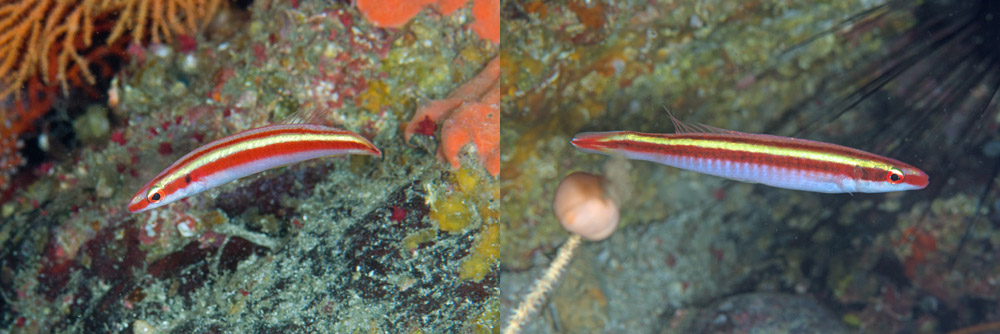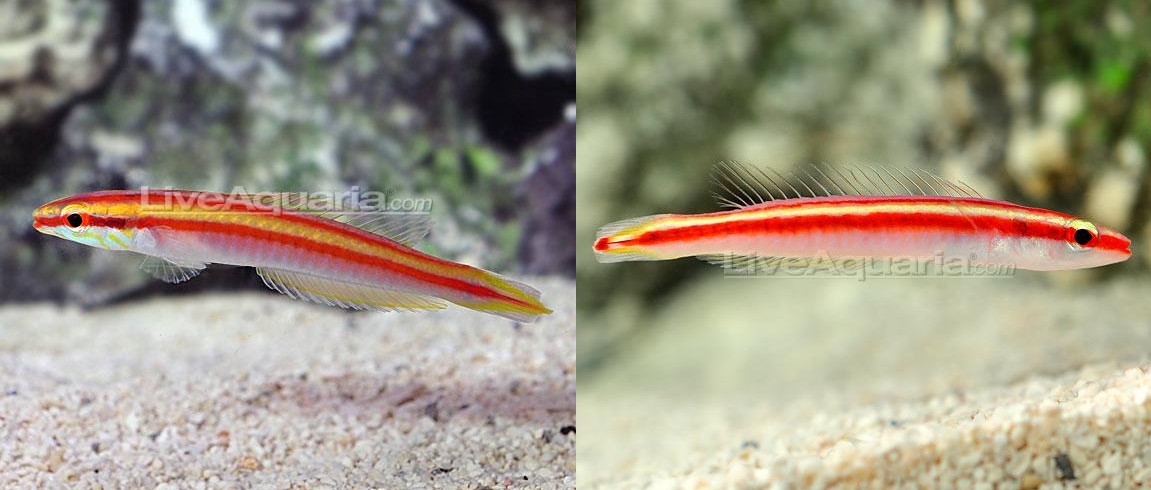Until quite recently, there was just a single recognized species of Terelabrus, but the past few years have seen this genus of small, deepwater hogfishes quickly expand. 2015 gave us the Yellow-striped Hogfish (T. dewapyle), a West Pacific species recognized by its yellow dorsal stripe and relatively clear dorsal fin. And this was followed soon after in 2016 by a third entry, the Indian Ocean’s T. flavocephalus, a species that aquarists have taken to calling the White-stripe or White Bar Hogfish.
Now there’s a fourth species to discuss, recently described in the journal Zootaxa, the Striped Hogfish (Terelabrus zonatus). It is named from two preserved specimens trawled at 70+ meters in Mindoro, Philippines, but there are unfortunately no known photographs of this fish in life. The justification used here by author Yoshino Fukui (who has described all recent additions to this genus) relates to some perceived differences in certain morphological counts, along with the appearance of numerous thin vertical bands in the preserved specimens.
But I’ll go on the record as saying that this species seems dubious. Let’s explore why…

Variants of Terelabrus dewapyle, observed together at Kashiwajima, Japan, 55 meters. Note the faint vertical bars developed in the specimen on the right (“zonatus” phenotype). Credit: kazkian
It’s important to understand just how little we know about this genus when it comes to the morphological and genetic variability of these species. In fact, when it comes to their genetics, we know essentially nothing, as there is simply no data for comparison. As far as morphology goes, only a handful of specimens have ever been studied; these are, after all, very uncommon in museum collections, even if they are regularly seen in aquarium exports.

Facial patterning variation within Indonesian T. dewapyle. These markings are less commonly seen in this this species, and their presence hasn’t been documented in the scientific literature. These specimens appear to be subadults, but note the variable presence of faint vertical bars here. Credit: LiveAquaria
When T. flavocephalus was described in 2016, it was on the basis of just a single aquarium specimen, and that’s still the only data we have for it. Its appearance clearly aligned it as a sister species to the Pacific’s T. dewapyle. Both have yellow in their dorsal stripe and in their facial markings, compared to the red and white pattern of T. rubrovittatus, the type species of this genus, and both have a mostly unpatterned dorsal fin. In general, T. flavocephalus tends towards having less yellow in its dorsal stripe (usually limited to the uppermost portion of this), and the single specimen that has been studied had a few additional lateral line scales (there have been a grand total of 6 specimens of T. dewapyle for which we have morphological data).
Now let’s get back to the new species, T. zonatus. It’s most notable phenotypic difference is the presence of 18 thin vertical bars in preserved specimens. This is where the common and scientific name stem from, but this same sort of patterning has been regularly observed in specimens of what appear to be T. dewapyle, having been documented alongside more typical unbarred specimens. Similarly, the lateral stripes of T. rubrovittatus also vary in appearance, likely due either to age or sex, with some appearing quite ragged and asymmetrical. This can be seen in the following videos…
Given how little we know of T. flavocephalus (again, there’s just one specimen documented), it’s not unreasonable to lump its limited morphological data in with that of its Pacific sister species, T. dewapyle, to get a broader understanding of this lineage as a whole. When we do this, we find that the data for T. zonatus overlaps in nearly all of the characters examined. For instance, the number of gill rakers are nearly identical (11-12 in zonatus vs. 12-13 in dewapyle/flavocephalus), and the number of lateral line scales falls somewhere in the middle (44 in zonatus vs. 41-46 in dewapyle/flavocephalus). For comparison, T. rubrovittatus is easily separated by having a greater number of gill rakers, 14-15, and possibly also more lateral line scales, 45-48, though this latter trait overlaps with the single known T. flavocephalus. The rest of the data used to distinguish T. zonatus (head pore counts, proportional measurements of the skull) can also be considered the sort that are still poorly understood and potentially variable given the limited amount of specimens examined thus far.
Without supporting genetic data or some sort of distinctive visual or biogeographic difference, it seems premature to consider these two specimens of “T. zonatus” as representative of a valid species. There have now been a considerable number of Terelabrus documented from the West Pacific, either from divers or aquarium collections, and the preponderance of the evidence points towards there being just two species in the region, the yellow-striped T. dewapyle and the white-striped T. rubrovittatus.
I’ll leave you with this beefy Terelabrus dewapyle (not rubrovittatus!) from Luiz Rocha…
Another treasure from Philippines deep reefs: Terelabrus rubrovittatus #WrasseWednesday #CASfieldnotes pic.twitter.com/C0DTDtOol8
— Luiz Rocha, PhD (@CoralReefFish) April 15, 2015
- Randall, J.E. and Fourmanoir, P., 1998. Terelabrus rubrovittatus, a new genus and species of labrid fish from New Caledonia and New Guinea. Bulletin of marine Science, 62(1), pp.247-252.
- Fukui, Y. 2018. A new species of Terelabrus (Perciformes: Labridae) from the Philippines with
- a key to species of Terelabrus and new record of Terelabrus dewapyle. Zootaxa, 4526(1), 084–090
- Fukui, Y. and Motomura, H., 2015. A new species of deepwater wrasse (Labridae: Terelabrus) from the western Pacific Ocean. Zootaxa, 4040(5), pp.559-568.
- Fukui, Y. and Motomura, H., 2016. Terelabrus flavocephalus sp. nov., a new hogfish (Perciformes: Labridae) from the Maldives, Indian Ocean. Ichthyological research, 63(4), pp.529-535.










0 Comments